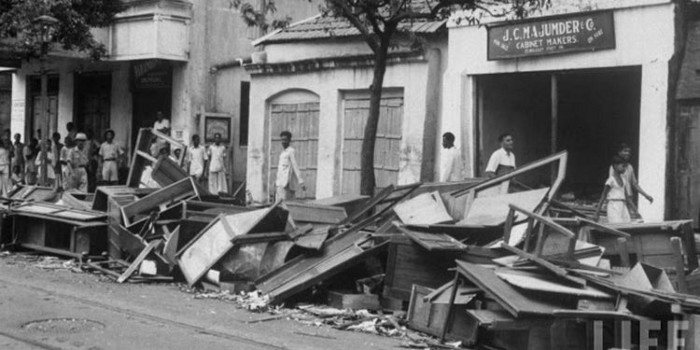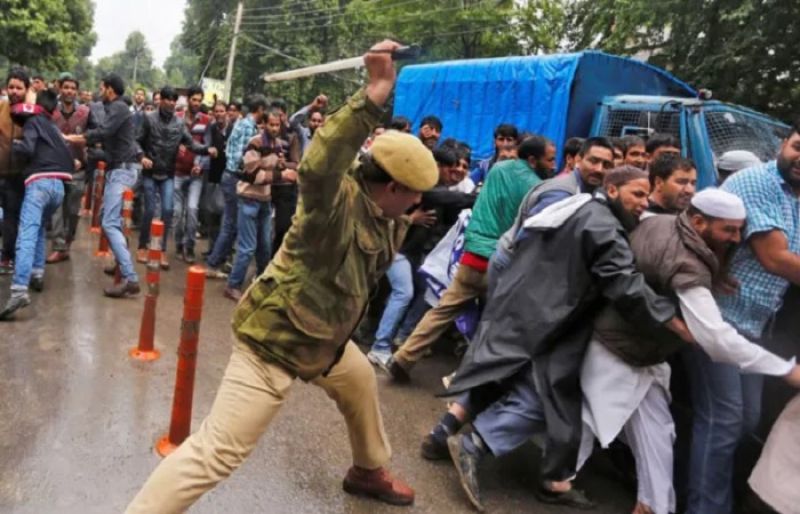
“The Mohammadan was running. The Hindu public was chasing him. I was leading the pack I was the first to catch up with him, and hit him with my rod on his head, then he fell down, and the public pounced on him after that,” said a Hindu man to an Indian journalist, describing in boastful detail of how he befell one of three Muslims he claims to have killed during the recent riots in New Delhi.
During a 96 hour period of government incited violence, a total of 47 Muslims were murdered in the most incomprehensibly gruesome and vicious ways at the hands of radicalized Hindu nationalists. Eyewitnesses, surviving victims and their families have recounted scenes that invoke memories of the previous century’s worst genocides. An 85 year-old woman was burnt alive by a mob chanting “Jai Shri Ram” (Victory to Lord Rama), and others were shot, bludgeoned or hacked to death.
Attackers also marked Hindu-owned properties with saffron-coloured flags to help their terrorists-in-arms identify Muslim targets, and thus mimicking a sinister measure used on the eve of the 2002 Gujarat riots, which left more than 2,000 Muslims killed and thousands more battered, raped, and abused.
What happened in New Delhi was not a “riot,” and nor should it be euphemized as “sectarian” or “communal” violence. It was an anti-Muslim pogrom fueled by a government that has weaponized Islamophobia to further its Hindu rashta agenda.
How did we get here?
Prime Minister Narendra Modi is governing the country as though he were the incarnation of Gopal ‘Patha’ Mukherjee, the feared Hindu gang leader of the middle 20th century who believed India could prosper in peace and tranquility only if every Muslim in the country was either killed or exiled.
In the wake of the ‘Great Calcutta Killings,’ which left 5,000 Muslims and Hindus dead during a three day period in August 1946, Mukherjee and his gang is said to have murdered hundreds of Muslims.
“It was a very critical time for the country. We thought if the whole area became Pakistan, there would be more torture and repression,” Mukherjee told Andrew Whitehead, a journalist who has compiled a prolific body of work on the history of India, Kashmir and Pakistan.
A British general, who witnessed Mukherjee’s led violence against Muslims in Calcutta, termed the killings as “unbridled savagery with homicidal maniacs let loose to kill and kill and maim and burn,” adding, “The underworld was taking control of the city. The police were not controlling it.”
Similarly, eyewitnesses and human rights groups accused police of either doing nothing to control the murderous Hindu mobs or participating in the violence. Videos show Delhi Police officers beating Muslims, shooting indiscriminately towards anti-CAA protesters and removing CCTV cameras in areas in predominately Muslim neighborhoods.
In 1946, Mukherjee was also reported to have said that 10 Muslims should be killed for every Hindu harmed by a Muslim in the country, which has become somewhat of a script for members of India’s ruling party today, including Uttar Pradesh chief minister Yogi Adityanath, a man handpicked by Modi, who said in 2015 that “if they [Muslims] kill one Hindu man, then we will kill 100 Muslim men.”
Mukherjee’s merciless violence against Muslims in Calcutta inspired awe among similarly minded Hindus in Bihar, giving birth to the “Bihar Riots,” which occurred from 24 October to 11 November, 1946, and left anywhere in the range of 8,000 to 20,000 Muslims dead.
“Pregnant woman were ripped up, their unborn babies torn out and infants’ brains bashed out on walls and on the ground. There was rape, and women and children were seized by the legs by burly friends and torn apart. Most were killed with spears but some of the killings were by strangulation. The murderers’ women stood about, laughing with glee, egging on their men folk,” reads an account from British General Francis Tucker in Remembering Partition: Violence, Nationalism and History in India (2002).
The horror of Bihar in 1946 would be repeated in Gujarat more than 50 years later when more than 2,000 Muslim men, women and children were massacred by mobs of violent Hindu extremists during a three day period spanning February 27 to March 1, 2002.
“A chilling technique, absent in pogroms unleashed hitherto but very much in evidence this time in a large number of cases, was the deliberate destruction of evidence. Barring a few, in most instances of sexual violence, the women victims were stripped and paraded naked, then gang-raped, and thereafter quartered and burnt beyond recognition. The leaders of the mobs even raped young girls, some as young as 11 years old . . . before burning them alive. . . . Even a 20-day-old infant, or a fetus in the womb of its mother, was not spared,” according to an international committee charged with investigating Gujarat’s anti-Muslim pogrom.
Modi was the chief minister of Gujarat at the time of the violence, and the government of the United States banned him from traveling to the country for his complicity in the murder of 2,000 Muslims.
Like Mukarjee before him, Modi has tapped into a violent form of Hindu nationalism that promotes intolerance of other faiths, particularly Islam, and traces its roots to the decades that followed the Indian Rebellion of 1857, which sought but failed to throw off the rule of the British Empire. In 1922, the Hindu nationalist movement gave birth to Rashtriya Swayamsevak Sangh (RSS), considered either the world’s largest paramilitary organization or world’s largest terrorist organization, depending on whom you ask.
It’s RSS that provides Modi and India’s ruling party their ideological DNA, and it’s why Muslims are being hunted, chased and killed in the streets by Hindu extremist mobs who enjoy the implicit and sometimes explicit support of the state. Published by CJ Werleman Independent, a crowdfunded and independent investigative journalism project that seeks to expose and end injustices against Muslims around the world.


